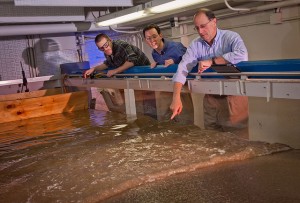
Aaron Birt ’12, left, and professors Daniel Sabatino and Lawrence Malinconico work in the newly refitted hydraulic flume lab.
Mechanical engineering major Aaron Birt ’12 (Billsburg, Pa.) is used to working out problems using his mind, but an independent study is giving him a chance to take a more hands-on approach.
Birt is refitting the geology department’s hydraulic flume lab with equipment that will allow it to model large waves. Using the new wave tank of his own design and construction, Birt will study how tsunami waves behave and the type of damage they cause to various types of coastline.
Seeing the damage caused in Japan by a tsunami last spring motivated Birt to study tsunami waves. While there is much research done on how to help buildings withstand tsunamis, there has been considerably less research done on waves themselves, Birt says. His initial idea was to try to develop a means of mitigating the effects of a tsunami wave, but he came to realize that the first step was going to have to be to create a repeatable wave, so that engineering problem became his focus for the fall.
Although Birt has taken courses in fluid dynamics, this field of study is new for him.
“I knew how fluid dynamics work but not in a tsunami wave,” he says.
Birt began by researching a design last fall and then he started building the components. Over winter break, he assembled the equipment. Birt’s design will still allow the flume to be used for river simulations and the added components will be available for other wave experiments. For example, Lawrence Malinconico, associate professor of geology and one of Birt’s advisers for the project, intends to use the setup for a laboratory exercise in his Geological Disasters class.
Birt built structures in the tank to simulate various kinds of coastline—such as harbors, coves, and open shoreline—that affect tsunami strength and the damage inflicted by tsunami waves. Now he can model how tsunamis behave in different environments.
“I enjoy studying this because it’s a natural disaster we’re hearing more about,” he says. “It’s a very pressing matter.”
Birt’s other adviser is Daniel Sabatino, assistant professor of mechanical engineering. He offered guidance on the mechanical design of the wave generator and provided insight into some of the fluid mechanics.
“I tried to help Aaron get practical experience in effectively using the analytical skills he has worked so hard to learn in the classroom,” says Sabatino. “With so much new understanding and so many analytical techniques at their disposal, it is often challenging for new engineers to know when they have done enough analysis. This type of experience is an excellent way for a student to find the most effective balance between analysis and testing. I am sure it will help Aaron gain confidence in his ability to find that balance once he graduates.”
Birt’s research is inherently multidisciplinary: A tsunami is caused by a geological event, but the modeling of the wave’s behavior and the techniques used to try and mitigate its effects on shore involve several different engineering disciplines.
“This is perhaps an ideal project for this interdisciplinary type of study. It involves both an understanding of the geological problem as well as the engineering possibilities to solve a geological problem,” Malinconico says. “I think there was a great symbiosis having advisers from two very different disciplines. Professor Sabatino was able to better comment on the mechanical aspects of the project while I was able to add suggestions relating to the nature of the wave that would be created and how it would have to react to the ‘ocean’ bottom and the shoreline.”
After graduating from Lafayette, Birt plans to attend Worcester Polytechnic Institute and pursue a degree in material science.
“This is my first experience taking an idea, developing a method of experiment, and doing all the work myself,” he says. “I realize how much I’ve advanced my knowledge in this subject.”
Sabatino agrees this project has helped Birt gain a better perspective of the challenges in bringing a concept to fruition.
“Despite an engineer’s effort to consider every aspect of a design, the unexpected will happen. I think Aaron is learning a great deal about the ‘the art of engineering’ in that he has experienced many unexpected challenges that required he adapt his approach and design,” he says. “Aaron is learning that he can rely on his analytical skills to eventually provide solutions to the problems he will face and that he must be persistent in his attempts to overcome those problems.”

3 Comments
Aaron: Great feature story! The FCA group is proud of you.
I was enthralled with the tsunami power from the Japan Quake, both on the coastal cities of Japan, such as Otsuchi and along the Oregon and California coasts. The shape of coastal harbors is such, that in some places, a tsunami can actually climb. I wish Aaron success in replicating a tsunami and, perhaps, in discovering new coastal dynamics. The lives of residents along the coast of the Pacific NW may depend on your research.
We are so proud of you, Aaron. I know that this project has meant a lot to you.
Comments are closed.